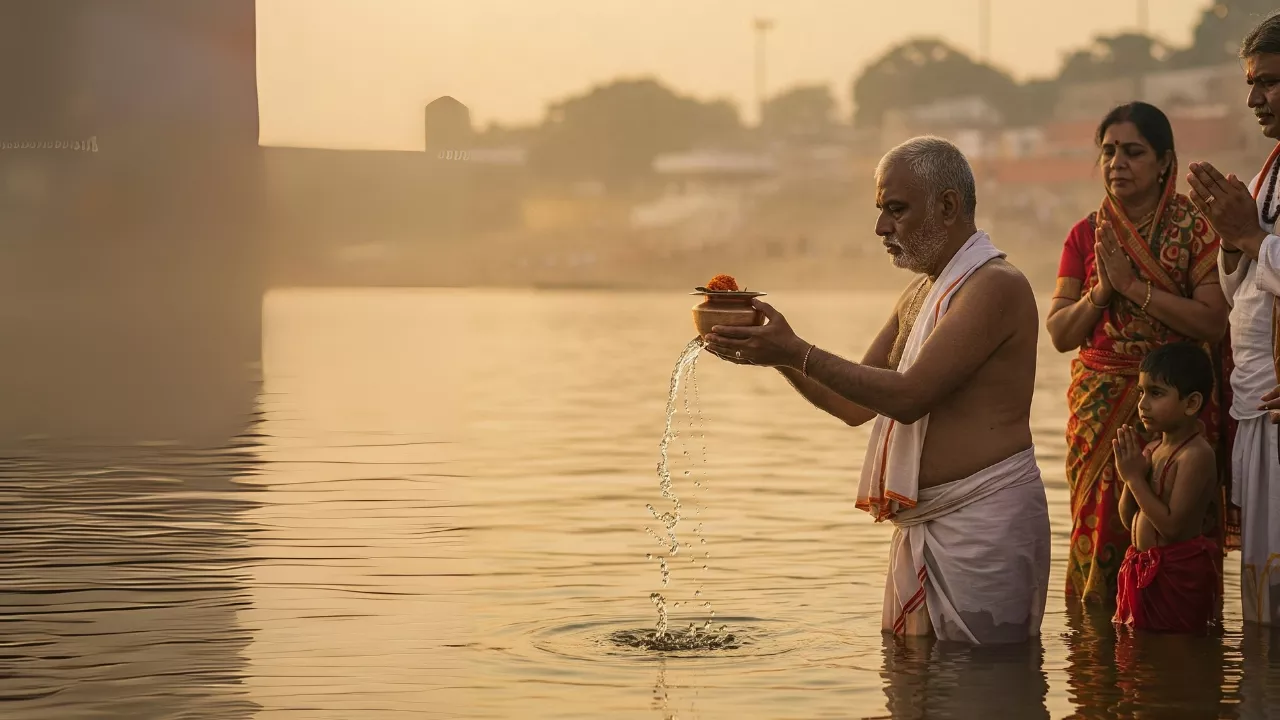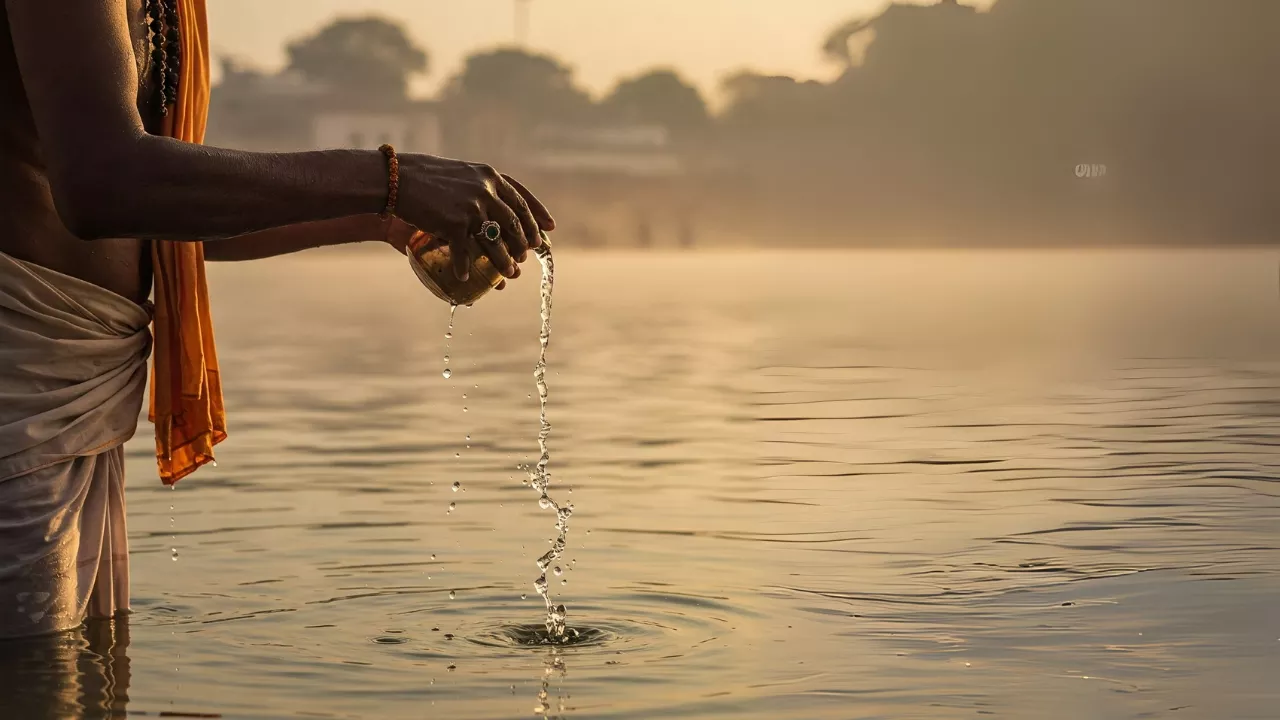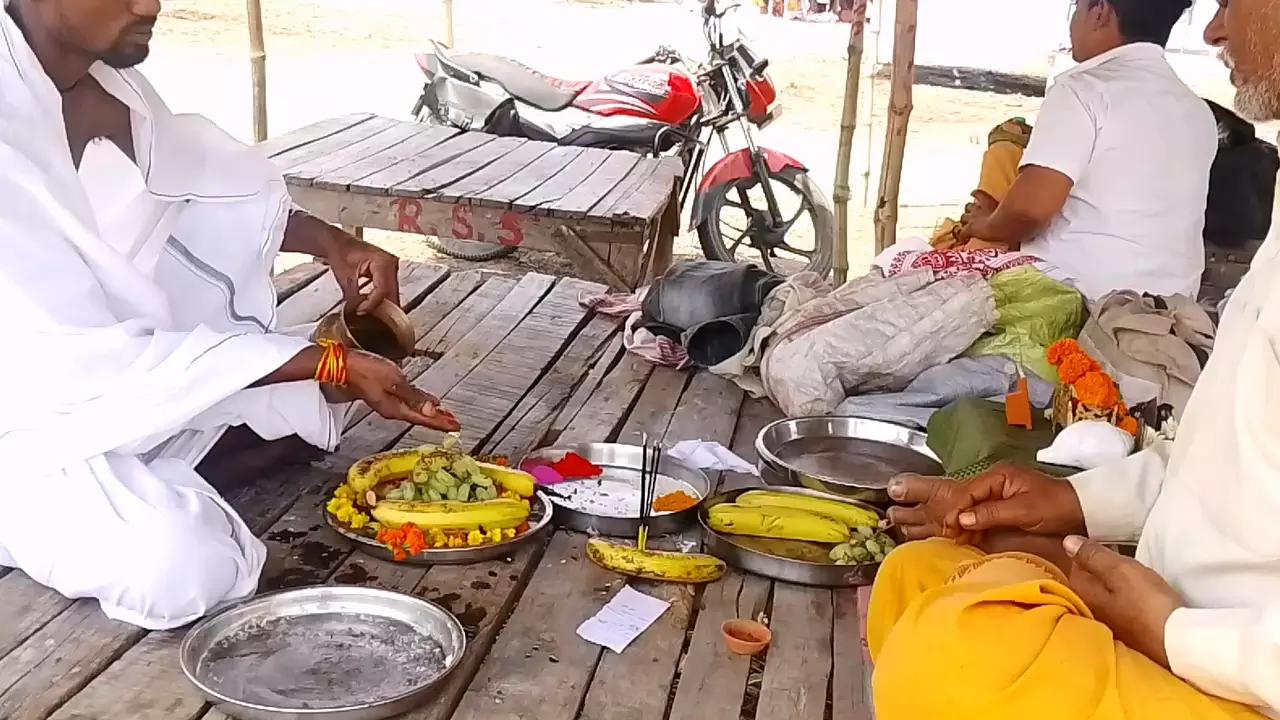Namaste,
Performing Pitru Tarpan – the direction one faces. Why, indeed, do we predominantly turn towards the South when offering our respects and sustenance to our departed ancestors (Pitṛs)? This is not an arbitrary choice; it is a practice steeped in the deep cosmological understanding and wisdom enshrined within our revered Puranas.
Understanding the facing south Pitru Tarpan practice requires us to gaze into the very structure of the cosmos as our ancestors perceived it, acknowledging the energies and entities associated with each cardinal point.
Dakṣiṇāmukha (दक्षिणमुख): Why Facing South is Paramount in Pitru Tarpan Rituals
In Sanatana Dharma, direction (Diśā) is never merely a geographical coordinate. Each direction is presided over by a guardian deity (Dikpāla) and possesses unique energetic qualities and symbolic associations. North is linked with Kubera (wealth) and auspicious growth, East with Indra (sovereignty) and Surya (new beginnings, divine knowledge), West with Varuna (cosmic waters, law). And the South (Dakṣiṇa)? The South holds a special, solemn significance directly tied to the cycle of life, death, and the journey beyond.

The Guardians of Directions (Dikpālas) and Their Significance
To fully grasp the importance of direction, we must acknowledge the Dikpālas, the divine guardians who preside over the eight directions (four cardinal, four intermediate):
- East (Pūrva): Indra (King of Devas, Thunder, Rain)
- Southeast (Āgneya): Agni (Fire God, Purification, Messenger)
- South (Dakṣiṇa): Yama (God of Death, Dharma, Justice)
- Southwest (Nairṛtya): Nirṛti (Goddess of Dissolution, Misery, Corruption)
- West (Paścima): Varuṇa (God of Waters, Cosmic Order, Oaths)
- Northwest (Vāyavya): Vāyu (Wind God, Life Breath)
- North (Uttara): Kubera (God of Wealth, Treasurer of Gods)
- Northeast (Īśānya): Īśāna (An aspect of Shiva, Knowledge, Consciousness)
Understanding this framework immediately highlights why the South is specifically relevant when dealing with matters concerning death and the afterlife.
The Southern Dominion: Realm of Yama and Pitru Loka
The most fundamental reason for facing south during Pitru Tarpan lies in the unshakable association of this direction with Lord Yama and the realm of the ancestors, known as Pitṛ Loka.
- Lord Yama (यम): Yama is not merely a fearsome figure but the embodiment of Dharma (righteousness) and Justice. He presides over the departure of the soul from the physical body and guides it according to its karma. His abode, Yamaloka or Naraka (for corrective suffering), and by extension, the entire process of judgment and transition after death, is traditionally situated in the South. He is Dakṣiṇāśāpati – the Lord of the Southern Direction.
- Pitṛ Loka (पितृ लोक): This is the specific realm where the souls of departed ancestors reside after completing their journey through Yama’s domain and before their next incarnation or liberation. It is a subtle realm, believed to be located southward from the earthly plane (Bhūloka).
Therefore, when we perform Tarpan or Shraddha<span style=”font-weight: 400;”>, we are attempting to connect with beings residing in this southern realm. Facing south Pitru Tarpan is thus a conscious act of:
- Respectful Orientation: Turning towards their abode is a sign of respect and acknowledgement. It’s like facing someone when you speak to them.
- Directing the Offering: It helps to energetically direct the subtle essence of our offerings (water, sesame seeds, food pindas, prayers) towards Pitṛ Loka.
- Aligning with Cosmic Order: It acknowledges the cosmic geography laid out in our scriptures and aligns the ritual with the presiding deity of that direction, Lord Yama, seeking his facilitation for the offerings to reach the ancestors.
Puranic Mandates: Scriptural Evidence for Facing South in Pitru Tarpan

Our sacred Puranas provide explicit instructions that confirm this practice. They don’t just suggest facing South; they often mandate it for specific ancestral rites.
Garuda Purana: Shraddha and the Southern Orientation
The Garuda Purana, a text particularly rich in details concerning death, the afterlife, and ancestral rites, provides clear guidance. It states that during the Shraddha ceremony (a comprehensive ritual involving food offerings, Pinda Daan, and Tarpan), the householder performing the rite “faces the south”. Furthermore, it specifies that the sacred thread (Yajñopavīta) should be worn in the Prācīnāvīta manner (over the right shoulder, under the left arm – the mode specifically for Pitṛ rites), and the sacred Pitṛ water (Tarpan water) is then poured towards the Brahmin representing the ancestors, emphasizing the southern orientation throughout the core part of the ritual. This text directly links the southern direction with the performance of Shraddha for the Pitṛs.
Skanda Purana: Tarpan for Yama and Pitṛs Facing South
The Skanda Purana, another vast repository of knowledge, reinforces this instruction specifically for Tarpan. It advises that when offering libations (Tarpan) with black sesame seeds (kṛṣṇa til) – the ingredient specifically pleasing to ancestors – to Lord Yama and the Pitṛs, the performer “should face the south”. It also reiterates the necessity of wearing the sacred thread in the Prācīnāvīta mode. This verse clearly connects the act of Tarpan itself, the recipients (Yama and Pitṛs), the key ingredient (black sesame), the sacred thread orientation, and the required direction (South). It leaves little room for doubt regarding the standard practice for facing south during Pitru Tarpan.
Varaha Purana: Pinda Daan Facing South
The Varaha Purana, while describing the offering of Pindas (पिण्ड – balls of rice or flour offered during Shraddha), provides corroborating evidence. It instructs that this crucial part of the ancestral rite should be performed “facing south” after laying Darbha grass (Kusha grass) on the floor. Pinda Daan is considered a direct offering of sustenance to the ancestors, and performing it while facing their southern abode reinforces the directional significance.
These consistent instructions across different Puranas (Garuda, Skanda, Varaha) and across different key ancestral rituals (Shraddha, Tarpan, Pinda Daan) solidify the primary importance of the southern direction. Facing south Pitru Tarpan is not just a suggestion; it’s a recurring scriptural mandate.
Symbolic Significance: What Does Facing South Represent?
Beyond the literal location of Pitṛ Loka, facing South during these rites carries deeper symbolic weight:
- Acknowledging Mortality: The South, ruled by Yama, reminds us of the impermanence of life and the inevitable transition of death. Facing it during ancestral rites acknowledges this reality with reverence and acceptance.
- Respect for the Past: It signifies turning towards our roots, our lineage, those who came before us and paved the way for our existence.
- Humility: It places us in a position of humility before the forces governing life, death, and dharma, and before the ancestors themselves, seeking their blessings.
- Channelling Gratitude: Our feelings of love, respect, and gratitude (kṛtajñatā) are consciously directed southward, towards the intended recipients.
- Energetic Alignment: Just as a compass needle aligns with magnetic north, facing south during Pitru Tarpan aligns our own subtle energy field with the frequency and direction associated with the ancestral realm, potentially making the connection stronger.
Addressing the Linga Purana: Understanding Alternative Perspectives
Now, it is the hallmark of our vast Sanatana Dharma that it accommodates multiple perspectives and acknowledges variations across traditions and texts. The input mentions the Linga Purana suggesting that Tarpan to the Pitṛs might be performed facing East or North. How do we reconcile this with the strong emphasis on the South elsewhere?
- Context Matters: The specific verse and its surrounding context in the Linga Purana would be crucial. Is it referring to a specific type of Tarpan (perhaps Nitya Tarpan done daily, which sometimes follows different rules than the specific Pitrupaksha Tarpan)? Is it part of a larger ritual where different deities associated with East/North are also being worshipped? Without the exact context, it’s hard to be definitive.
- Different Schools/Sampradāyas: Hinduism encompasses diverse schools of thought and regional traditions (sampradāyas). It’s possible that some specific lineages or traditions followed practices outlined in the Linga Purana, prioritizing other aspects (like alignment with morning sun – East, or auspiciousness – North) even for Pitṛs in certain situations.
- Complementary, Not Contradictory?: Perhaps the Linga Purana reference isn’t meant to replace the southern direction but offers alternatives under specific circumstances or for specific types of ancestral beings (e.g., divine ancestors vs. recently departed).
- Predominance of South: While acknowledging the Linga Purana’s statement, it’s crucial to recognize that the overwhelming weight of Puranic evidence and widespread traditional practice strongly favors facing south for Pitru Tarpan and Shraddha. The connection between South, Yama, and Pitṛ Loka is a cornerstone of this ritual complex found repeatedly in authoritative texts like Garuda and Skanda Puranas.
Therefore, while we respectfully acknowledge the alternative mentioned in the Linga Purana, the standard, most widely accepted, and strongly scripturally supported direction for rites specifically focused on satisfying the Pitṛs remains South (Dakṣiṇa).
Practical Integration: Facing South with Other Ritual Elements
The requirement of facing south Pitru Tarpan doesn’t exist in isolation. It works synergistically with other elements of the ritual:
- Prācīnāvīta Yajñopavīta: Wearing the sacred thread over the right shoulder is the posture specifically for Pitṛ rites, complementing the southern direction.
- Pitṛ Tīrtha Mudra: Offering water through the space between the thumb and forefinger (Pitṛ Tīrtha) aligns the hand posture with the ancestral offering, further enhanced by facing their direction.
- Kusha Grass Pointing South: Often, the Darbha grass used is placed with its tips pointing South.
All these elements work together, creating a cohesive ritualistic field oriented towards the ancestors.

What If Facing South is Physically Impossible?
Our Dharma is practical and compassionate. What if the layout of one’s home, travel circumstances, or physical limitations make strictly facing South impossible?
- Prioritize Intent (Bhāva): The most crucial element is always Shradh– faith, sincerity, and devotion. If physical orientation is impossible, perform the ritual facing the cleanest available direction, but mentally orient yourself strongly towards the South, visualizing your offerings reaching the Pitṛ Loka.
- Minimal Adjustment: If exact South isn’t possible, try to face Southeast or Southwest as the next best alternatives.
- Focus on Other Elements: Ensure all other aspects of the ritual (purity, ingredients like black sesame and Kusha, correct hand posture, mantras, heartfelt prayers) are performed correctly.
While physical direction is important, sincere intention can overcome many limitations. However, whenever possible, adhering to the tradition of facing south during Pitru Tarpan is highly recommended.
Conclusion: The Compass of Tradition Points South
The practice of facing south during Pitru Tarpan is deeply rooted in the cosmological understanding articulated in our Puranas. It is a conscious alignment with the realm of Lord Yama and the Pitṛ Loka, a mark of profound respect, and a method prescribed by venerable texts like the Garuda Purana, Skanda Purana, and Varaha Purana to ensure the efficacy of our offerings.
It is the direction that acknowledges the journey of the soul, honours the guardians of cosmic order, and facilitates the energetic connection between us and those who reside in the ancestral realm. While acknowledging the vastness of our tradition which may contain alternative perspectives like the one hinted at in the Linga Purana, the overwhelming consensus and practice point firmly South.
Let this understanding deepen your reverence as you perform these sacred duties. When you turn to the South, feel the connection to your lineage, offer your prayers and libations with focused intent, and trust in the wisdom of our ancestors who established these profound practices. May your offerings reach their destination, may your Pitṛs bestow their blessings upon you, and may your path always be guided by Dharma.
|| कल्याणमस्तु ||
